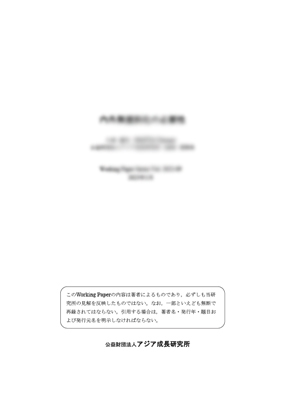Alternative Estimates of TFP Growth in China: Evidence from Application of the Dual Approach

| Author | Nazrul Islam, Erbiao Dai |
|---|---|
| Date of Publication | 2007. 2 |
| No. | 2007-03 |
| Download | 430KB |
Contents Introduction
This paper presents alternative sets of dual estimates of TFP growth rate in China based on alternative assumptions regarding the rate of return to capital in the “non-manufacturing” or
“Other” sector ( rO ). The purpose is to put the dual estimation of the Chinese TFP growth on a more robust foundation. Earlier, in view of paucity of direct data on rO , Islam, Dai, and Sakamoto (2006) followed, what we call in the current paper, a Hybrid route to compute rO in a
residual manner by subtracting manufacturing value added obtained from China Industry Economy Statistical Yearbook (CIESY) from the economy-wide value added obtained from National Income Accounts (NIA). This approach however is not entirely satisfactory, because the computation then reverts to NIA, from which the dual approach strives to depart. In the
Chinese case, the Hybrid route also, by construction, induces an upward trend in rO , causing
thereby an upward bias in the resulting dual estimates of TFP. This paper therefore offers two other sets of TFP estimates. The first of these assumes that the rate of return to capital in nonmanufacturing sector is the same as to be found in the CIESY data for the Non State Enterprises (NSE) part of the manufacturing sector. This is therefore called the CIESY route, whose merit
lies in the fact that it avoids using NIA data for computation of rO . The problem however is that
this route entails imposition of a sharply declining trend (that holds for the NSE part of the manufacturing sector) on a much wider swath of the Chinese economy, causing thereby a downward bias in the dual estimate of TFP growth. The paper therefore presents a third set of
dual estimates, obtained following the Neutral route that is based on the assumption that rO
displays neither an upward nor a downward trend. The paper suggests estimates obtained from Hybrid and CIESY routes as the upper and lower bounds, respectively, of the TFP estimates and offers estimates from the Neutral route as the preferred ones. The qualitative features of the results presented in this paper prove to be the same as those presented in Islam, Dai, and Sakamoto (2006). Thus, TFP growth proves to be an important source of growth for China during the entire post reform period. Second, there has been some slowdown in TFP growth with the rate proving lower in more recent years than what it was in the initial years of reform.
